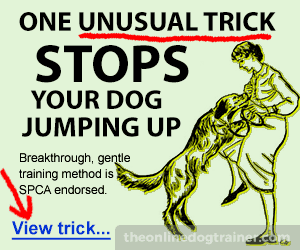Preventing Dog Bites
By The US Center for Disease Control

A few years ago a friend of mine was bitten by one of her mother’s dogs. It was a serious bite and her arm was bleeding badly, but she was visiting from out of town and resisted the idea of going to a local emergency room.
I explained to her how there were horses on her mom’s property, and the dog was sometimes in the pasture — and how horse barns are a prime place for contracting tetanus! (I learned that from a work of fiction I’m glad I read.) Thankfully she went and got a shot.
I want to share this information from the CDC, regarding the danger of dog bites and how to prevent them:
Approximately 4.5 million dog bites occur each year in the United States. Almost 1 out of 5 bites becomes infected. Don’t be a victim.
Dogs can be our closest companions. They often live in our homes, have been proven to decrease stress, increase our exercise levels, and are frequent playmates for children. But sometimes man’s best friend will bite. In addition to causing pain, injury, or nerve damage, dog bites can become infected, placing the bite victim at risk for illness or even death.
Click here to fix your dog's behavior problem and get started with dog obedience training.
Though the idea of being bitten by a dog is scary, it doesn’t mean that it is time to send Fido packing. People who work and live around dogs should be aware of the risk and take precautions. With a few tips, you can learn how to prevent dog bites and reduce the risk of illness and injury.
Doggy Dan muzzles a pit bull as a precaution when introducing her to other dogs
Access all 100+ videos for 3 days for just $1
Or first, let me tell you what it's like to be a member
Who is most at risk for dog bites?
- Children. Among children, the rate of dog-bite-related injuries is highest for those 5 to 9 years old. Children are more likely than adults to receive medical attention for dog bites.
- Men. Men are more likely than women to be bitten by a dog.
Where do dog bites happen?
It may surprise you to know that over half of dog-bite injuries occur at home with dogs that are familiar to us. Among children and adults, having a dog in the household is associated with a higher likelihood of being bitten than not having a dog. As the number of dogs in the home increases, so does the likelihood of being bitten. Adults with two or more dogs in the household are five times more likely to be bitten than those living without dogs at home.
Preventing dog bites – Basic safety tips
Do:
- Remain motionless (e.g., “be still like a tree”) when approached by an unfamiliar dog.
- Curl into a ball with your head tucked and your hands over your ears and neck if a dog knocks you over.
- Immediately let an adult know about stray dogs or dogs that are behaving strangely.
Don’t:
- Approach an unfamiliar dog.
- Run from a dog.
- Panic or make loud noises.
- Disturb a dog that is sleeping, eating, or caring for puppies.
- Pet a dog without allowing it to see and sniff you first.
- Encourage your dog to play aggressively.
- Let small children play with a dog unsupervised.
What do you do if an unfamiliar dog approaches you and you do not want to interact with a dog?
- Stop! Stay still and be calm.
- Do not panic or make loud noises.
- Avoid direct eye contact with the dog.
- Say “No” or “Go Home” in a firm, deep voice.
- Stand with the side of your body facing the dog. Facing a dog directly can appear aggressive to the dog. Instead, keep your body turned partially or completely to the side.
- Slowly raise your hands to your neck, with your elbows in.
- Wait for the dog to pass or slowly back away.
What if you get bitten or attacked by a dog?
- Put your purse, bag, or jacket between you and the dog to protect yourself.
- If you are knocked down, curl into a ball with your head tucked in and your hands over your ears and neck.
When you get to a safe place, immediately wash wounds with soap and water. Seek medical attention, especially:
- If the wound is serious (uncontrolled bleeding, loss of function, extreme pain, muscle or bone exposure, etc.).
- If the wound becomes red, painful, warm, or swollen, or if you develop a fever.
- If it has been more than 5 years since your last tetanus shot and the bite is deep.
Because anyone who is bitten by a dog is at risk of getting rabies, consider contacting your local animal control agency or police department to report the incident, especially:
- If you don’t know if the dog has been vaccinated against rabies.
- If the dog appears sick or is acting strangely.
If possible, contact the owner and ensure the animal has a current rabies vaccination. You will need the rabies vaccine license number, name of the veterinarian who administered the vaccine, and the owner’s name, address, and phone number.
Minor wounds
- Wash the wound thoroughly with soap and water.
- Apply an antibiotic cream.
- Cover the wound with a clean bandage.
- See a healthcare provider if the wound becomes red, painful, warm, or swollen; if you develop a fever; or if the dog that bit you was acting strangely.
Deep wounds
- Apply pressure with a clean, dry cloth to stop the bleeding.
- If you cannot stop the bleeding or you feel faint or weak, call 911 or your local emergency medical services immediately.
- See a healthcare provider as soon as possible.
See a healthcare provider immediately
- If wounds appear infected (red, painful, warm, or swollen).
- If you do not know the dog or if the dog does not have a current rabies vaccination certificate, because you might need treatment to prevent rabies.
What diseases can you get from dog bites?
In addition to causing injury, dog bites can spread germs from dogs to people. On average, up to 18% of dog bites become infected with bacteria. Over 60 different kinds of bacteria have been found in dog mouths, but only a handful of these germs can make you sick. You should be aware of the following diseases that can result from dog bites:
Rabies is one of the most serious diseases people can get from dog bites. Although getting rabies from a dog in the United States is rare, rabies is a disease that you should be aware of. Rabies is a virus that affects the brain and is almost always fatal. The most common way rabies virus is spread is through the bite and saliva of an infected animal. The disease can be prevented by vaccinating dogs. People who are exposed to a dog or any animal that could have rabies should receive treatment immediately to prevent rabies.
Capnocytophaga spp. are bacteria that live in the mouths of humans, dogs, and cats. These bacteria do not make dogs or cats sick. Rarely, Capnocytophaga spp. can spread to humans through bites, scratches, or close contact from a dog or cat and cause illness. Most people who have contact with dogs or cats do not become sick. People with a weakened immune system (making it more difficult for their bodies to fight infection) are at greater risk of becoming sick.
Pasteurella is a type of bacteria seen in over 50% of infected dog bite wounds. Pasteurella commonly causes a painful, red infection at the site of the bite but can cause more serious disease in people with a weak immune system. Often these signs are accompanied by swollen glands, swelling in the joints, and difficulty moving.
MRSA (methicillin-resistant Staphylococcus aureus) is type of Staph infection that is resistant to a certain group of antibiotics. Dogs and other animals can carry MRSA without showing any symptoms, but the bacteria can cause skin, lung, and urinary tract infections in people. In some people, MRSA can spread to the bloodstream or lungs and cause life-threatening infections.
Tetanus is a toxin produced by a type of bacteria called Clostridium tetani. This toxin causes rigid paralysis in people and could be a problem in deep bite wounds.
Any dog can bite, but if you understand the risks for dog bites and know how to protect yourself, you will reduce your likelihood of getting sick or injured.
Click here to fix your dog's behavior problem and get started with dog obedience training.






